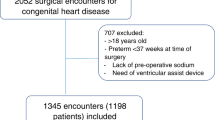Abstract
Purpose
Hypernatremia is common in the medical Intensive Care Unit (ICU) and has been described as an independent risk factor for mortality. Hypernatremia has not yet been studied in a collection of ICU patients after cardiothoracic surgery. Therefore, we wanted to determine the incidence of hypernatremia in a surgical ICU and its association with outcomes of critically ill surgical patients.
Methods
In this retrospective cohort study performed at a surgical ICU of a university hospital in Vienna, patients were admitted to the ICU after major cardiothoracic surgery between May 1999 and October 2007. Data on serum sodium in the ICU, ICU mortality, hospital mortality, and length of ICU stay were collected prospectively.
Results
2,699 patients underwent surgery during the study period, and 2,314 patients were included in the study. Two hundred twenty-one (10%) patients acquired hypernatremia during their ICU stay. Median onset of hypernatremia was on day 4 (2–7). Patients with ICU-acquired hypernatremia had a higher ICU mortality (19%) compared to patients without hypernatremia (8%; p < 0.01). Length of ICU stay was increased in patients with hypernatremia (17 vs. 3 days; p < 0.01). In a multivariate Cox regression, ICU-acquired hypernatremia was an independent risk factor for ICU mortality within 28 days.
Conclusions
Hypernatremia is a common event early in the course of critical illness after major cardiothoracic surgery and is independently associated with ICU mortality within 28 days. Future research should focus on the impact of hypernatremia on physiological functions as well as adequate and safe treatment of the electrolyte disorder.



Similar content being viewed by others
References
Lindner G, Funk GC, Schwarz C, Kneidinger N, Kaider A, Schneeweiss B, Kramer L, Druml W (2007) Hypernatremia in the critically ill is an independent risk factor for mortality. Am J Kidney Dis 50:952–957
Polderman KH, Schreuder WO, Strack van Schijndel RJ, Thijs LG (1999) Hypernatremia in the intensive care unit: an indicator of quality of care? Crit Care Med 27:1105–1108
Hoorn EJ, Betjes MG, Weigel J, Zietse R (2008) Hypernatraemia in critically ill patients: too little water and too much salt. Nephrol Dial Transplant 23:1562–1568
Stelfox HT, Ahmed SB, Khandwala F, Zygun D, Shahpori R, Laupland K (2008) The epidemiology of intensive care unit-acquired hyponatraemia and hypernatraemia in medical-surgical intensive care units. Crit Care 12:R162
Nashef SA, Roques F, Michel P, Gauducheau E, Lemeshow S, Salamon R (1999) European system for cardiac operative risk evaluation (EuroSCORE). Eur J Cardiothorac Surg 16:9–13
Le Gall JR, Lemeshow S, Saulnier F (1993) A new Simplified Acute Physiology Score (SAPS II) based on a European/North American multicenter study. JAMA 270:2957–2963
Adrogue HJ, Madias NE (2000) Hypernatremia. N Engl J Med 342:1493–1499
Rose BD (2001) Clinical physiology of acid-base and electrolyte disorders. McGraw-Hill, New York
Knochel JP (1982) Neuromuscular manifestations of electrolyte disorders. Am J Med 72:521–535
Lenz K, Gossinger H, Laggner A, Druml W, Grimm G, Schneeweiss B (1986) Influence of hypernatremic-hyperosmolar state on hemodynamics of patients with normal and depressed myocardial function. Crit Care Med 14:913–914
Kozeny GA, Murdock DK, Euler DE, Hano JE, Scanlon PJ, Bansal VK, Vertuno LL (1985) In vivo effects of acute changes in osmolality and sodium concentration on myocardial contractility. Am Heart J 109:290–296
Bratusch-Marrain PR, DeFronzo RA (1983) Impairment of insulin-mediated glucose metabolism by hyperosmolality in man. Diabetes 32:1028–1034
Kuroda T, Harada T, Tsutsumi H, Kobayashi M (1997) Hypernatremic suppression of neutrophils. Burns 23:338–340
Halperin ML (1999) Fluid, electrolyte and acid–base physiology: a problem-based approach. WB Saunders, Philadelphia
Palevsky PM, Bhagrath R, Greenberg A (1996) Hypernatremia in hospitalized patients. Ann Intern Med 124:197–203
Bennani SL, Abouqal R, Zeggwagh AA, Madani N, Abidi K, Zekraoui A, Kerkeb O (2003) Incidence, causes and prognostic factors of hyponatremia in intensive care. Rev Med Interne 24:224–229
Acknowledgments
We thank the Department of Cardiothoracic and Vascular Anesthesia medical staff for their contributions to the database. No financial support was received for this study.
Author information
Authors and Affiliations
Corresponding author
Additional information
The study was undertaken at the Cardiothoracic Surgical ICU, Medical University of Vienna.
Electronic supplementary material
Below is the link to the electronic supplementary material.
Rights and permissions
About this article
Cite this article
Lindner, G., Funk, GC., Lassnigg, A. et al. Intensive care-acquired hypernatremia after major cardiothoracic surgery is associated with increased mortality. Intensive Care Med 36, 1718–1723 (2010). https://doi.org/10.1007/s00134-010-1968-4
Received:
Accepted:
Published:
Issue Date:
DOI: https://doi.org/10.1007/s00134-010-1968-4




